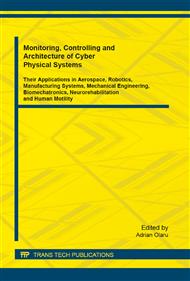[1]
K. S. Yeung AND P. H. Thornton, Transient Thermal Analysis of Spot Welding Electrodes, Supplement to the Welding Journal, January 1999, pp. 1s-6s.
Google Scholar
[2]
C. G. Ceorapin, R. Iovanas, I. Voiculescu, D.M. Iovanas, A. Pascu, Spot Welding Electrodes with the Active Area Achieved by Clading with M.M.A. Welding, Annals of DAAAM for 2009 & Proceedings of the 20th International DAAAM Symposium, Volume 20, No. 1, (2009).
Google Scholar
[3]
Zhan Y., Zhang G., The effect of interfacial modifying on the mechanical and wear properties of SiCp/Cu composites, Materials Letters, 2003; 57, pp.4583-4591.
DOI: 10.1016/s0167-577x(03)00365-3
Google Scholar
[4]
Jiasheng Zou, Qizhang Zhao, Zheng Chen, Surface modified long-life electrode for resistance spot welding of Zn-coated steel, Journal of Materials Processing Technology 209 (2009) p.4141–4146.
DOI: 10.1016/j.jmatprotec.2008.10.005
Google Scholar
[5]
Ch. Delavet, G. Iacobescu, O. Dontu, I. Voiculescu, D. Besnea, E.M. Stanciu, A.C. Pavalache, Cooper-Carbide Composite Layer Obtained By Laser Beam Remelting", International Conference MECAHITECH, 09, Bucharest, 2009, pp.113-118.
Google Scholar
[6]
M. J. Tobar, C. Alvarez, J.M. Amando, G. Rodriguez, A. Yanez, Morphology and characterization of laser clad composite NiCrBSi–WC coatings on stainless steel, Surface and coatings technology, Vol. 200, Issues 22-23, June 2006, pp.6313-6317.
DOI: 10.1016/j.surfcoat.2005.11.093
Google Scholar
[7]
W.A., Glaeser, Wear properties of heavy Loaded Cooper-Base Bearing Alloys, Journal of Metals, 1983, pp.1-6.
Google Scholar
[8]
S. Kang, A study of friction and wear characteristics of copper- and iron-based sintered materials, Wear, Vol. 162-164, Part. 2, 1993, pp.1123-1128.
DOI: 10.1016/0043-1648(93)90131-5
Google Scholar
[9]
CSM Instrument Application Bulletin, (2004).
Google Scholar
[10]
M.G. Gee et al, WOM 14th International conference on Wear of Materials, USA, Wear 255 (2003) pp.1-13.
Google Scholar
[11]
M. M Stack, M. Mathew, WOM 14th International conference on Wear of Materials, USA, Wear 255, 2003, pp.14-22.
Google Scholar
[12]
A. Sivitski, M. Ajaots, P. Põdra, Wear of PVD Hard Coatings in Sliding Contacts, 6th International DAAAM Baltic Conference Industrial Engineering, 24-26 April 2008, Tallinn, Estonia, pp.1-6.
Google Scholar


